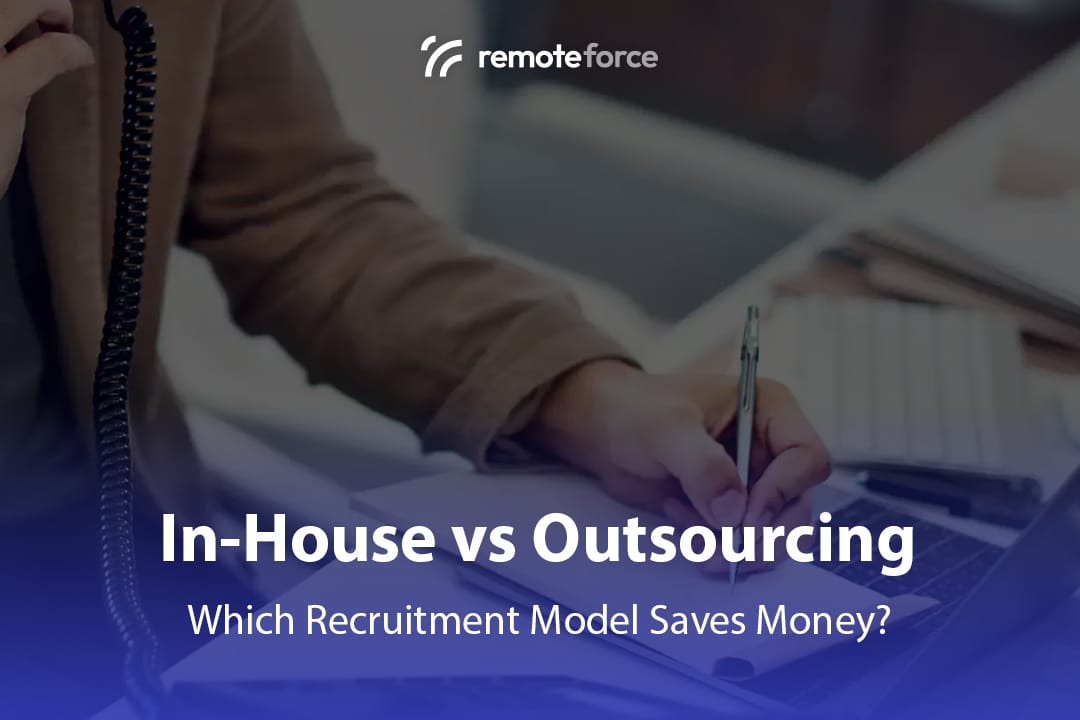For growing businesses, talent acquisition is a critical function, but it’s also one of the most expensive. The decision to manage recruitment in-house or leverage Recruitment Process Outsourcing (RPO) often comes down to perceived cost. While a basic salary for an in-house recruiter seems cheaper on paper, the Total Cost of Ownership (TCO) for an in-house function can be surprisingly high.
This guide breaks down the true financial comparison between in-house and outsourced recruitment, helping you determine which model truly saves your business money and provides better value.
Table of Contents
ToggleThe True Cost of In-House Recruitment
When calculating the cost of running an in-house recruitment department, many businesses only consider the recruiter’s salary. However, the TCO involves significant direct and hidden expenses.
1. Direct Costs (Fixed & Variable)
| Cost Component | Description | Financial Impact |
|---|---|---|
| Recruiter Salary & Benefits | Base salary, mandatory social security, health insurance, and vacation/sick leave. | Fixed/High: A substantial recurring monthly expense, regardless of hiring volume. |
| Software & Tools | Annual or monthly subscriptions for Applicant Tracking Systems (ATS), CRM, premium LinkedIn Recruiter licenses, and job board posting fees. | Fixed/High: Specialized, expensive tools are required to be competitive in the modern hiring landscape. |
| Sourcing Costs | The actual money spent on job advertisements (Indeed, local job boards) and specialized platform access. | Variable: Increases dramatically during high-volume hiring periods. |
| Training & Development | Cost of professional development, certification maintenance, and attending industry events for the in-house team. | Fixed: Necessary investment to keep recruiters effective. |
2. Hidden & Opportunity Costs
These are the costs often overlooked, yet they severely impact the budget and business operations:
- Cost of Empty Desks (Time-to-Hire): When a critical position remains unfilled, the business suffers a loss of potential revenue or productivity. A slow in-house process incurs higher opportunity cost.
- Cost of Poor Hire: The expense of rehiring, severance pay, and the productivity loss associated with an employee who doesn’t work out.
- Administrative Overhead: The use of shared company resources (IT support, HR internal management, facility usage, etc.) dedicated to the recruitment function.
- Fluctuating Workload Risk: Paying a full-time recruiter during low-hiring months when they are underutilized.
The Cost Structure of Outsourced Recruitment (RPO)
Recruitment Process Outsourcing (RPO) involves partnering with a vendor (like RemoteForce) to take over all or part of your talent acquisition process. The costs are generally transparent and tied directly to output or resource utilization.
1. Cost Per Hire (CPH) Model (Transactional)
This model is typically used when a business needs to fill a specific number of roles and pays a set fee for each successful placement.
- Predictability: Highly predictable for short-term projects or unique, highly specialized roles.
- TCO Benefit: You only pay when a candidate is hired, transferring the risk of time and resource expenditure entirely to the vendor.
2. Management Fee or FTE Model (Strategic)
This model, similar to the FTE model, is the most common and strategic RPO pricing. The client pays a fixed monthly fee for a Dedicated Team of Recruiters working exclusively on their mandate.
| RPO Cost Component | Description | Financial Benefit |
|---|---|---|
| Fixed Monthly Fee (FTE) | One predictable invoice covers the salary, benefits, and management of the dedicated RPO team. | Ultimate Budget Stability: Converts variable costs into a predictable operational expenditure (OpEx). |
| Tooling & Infrastructure | The RPO vendor uses their own premium ATS, CRM, job board subscriptions, and licenses. | Zero Capital Expenditure (CapEx): You get access to the best tools without buying them. |
| Scalability Cost | The cost to ramp up or down resources is included in the service agreement. | Zero Attrition Cost: The vendor immediately manages and pays for replacing any recruiter who leaves the team. |
The Comparative Cost Simulation: When RPO Wins
The strategic advantage of RPO becomes clear when comparing the TCO over a full business cycle (including high and low volume periods).
Scenario: Hiring 10 Mid-Level Developers Annually
| Cost Category | In-House Model (1 Recruiter) | RPO Model (Dedicated FTE) | Winner |
|---|---|---|---|
| Annual Recruiter Salary & Benefits | $80,000 | N/A (Included in monthly fee) | RPO (Cost is shared across clients for vendor) |
| ATS & Premium Subscriptions | $15,000 | $0 (Vendor uses own tools) | RPO |
| Time-to-Hire (Opportunity Cost) | High (Average 90+ days, leading to lost revenue) | Low (Average 45-60 days due to specialized focus) | RPO |
| Cost of Attrition | High (Internal HR cost to find a new recruiter) | Zero (Vendor instantly replaces staff at their cost) | RPO |
| Low-Volume Risk | High (Paying $80k salary when only 2 people are hired) | Low (Fee can be adjusted/scaled down easily) | RPO |
| Legal Compliance Risk | Moderate (Relies on internal team’s legal knowledge) | Low (Vendor guarantees local labor law compliance) | RPO |
Conclusion from Simulation: While the annual fixed cost of an RPO FTE might appear similar to the in-house recruiter’s fully loaded cost, the RPO model dramatically lowers the variable costs, eliminates CapEx, and mitigates the costly risks associated with attrition, underutilization, and legal non-compliance.
Beyond Cost: The Strategic Value
When the cost difference is marginal, the decision should pivot to value. RPO delivers strategic advantages that in-house teams often cannot match:
- Specialized Talent: Access to recruiters who specialize in niche fields (e.g., web development or legal compliance), which is crucial for RemoteForce’s service areas.
- Scalability: RPO teams can scale up or down instantly to meet the demands of business peaks (e.g., funding rounds or seasonal growth) without the client needing to hire and fire.
- Focus on Core Business: Outsourcing recruitment allows your internal leadership to focus purely on driving business growth and strategy, not on managing the hiring pipeline.
Conclusion
The simplistic view that in-house recruitment is cheaper rarely holds true when calculating the Total Cost of Ownership. Recruitment Process Outsourcing (RPO) is a financially superior choice for businesses seeking budget predictability, instant access to premium tools, and a reliable mechanism for mitigating legal and administrative risks. It converts the volatile, high-risk process of talent acquisition into a stable, high-value investment.
Ready to lower your hidden recruitment overhead and partner with RPO experts? RemoteForce offers scalable RPO solutions tailored for specialized roles—from certified digital marketers to web developers—ensuring you acquire the best talent at a transparent, predictable cost.




